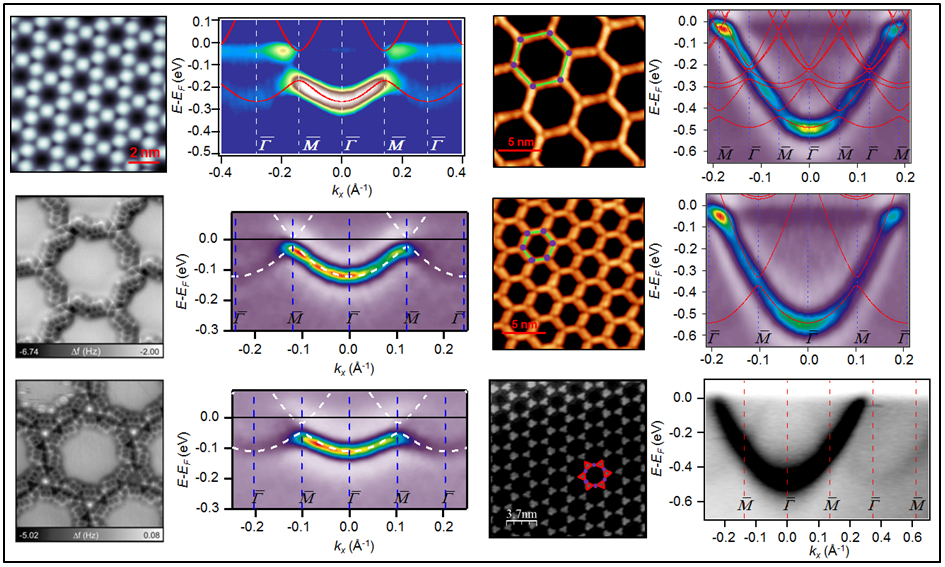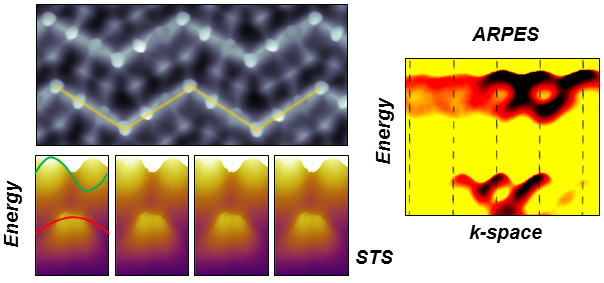PhD Thesis Defense- Ignacio Piquero Zulaica
 Electronic Bands of Nanoporous Networks and One-Dimensional Covalent Polymers Assembled on Metal Surfaces
Electronic Bands of Nanoporous Networks and One-Dimensional Covalent Polymers Assembled on Metal Surfaces
Candidate: Ignacio Piquero Zulaica
Supervisors: Dr. Jorge Lobo-Checa and Prof. J. Enrique Ortega
Research group: Nanophysics Laboratory
When: November 30 (10:00h)
Where: CFM Auditorium
Summary

ARPES electronic band structure of the studied nanoporous networks in a nutshell (left and right columns): 3deh-DPDI metal-organic network on Cu(111), Single Wall and Double Wall halogen bond stabilized nanoporous networks grown on 3ML Ag/Au(111) for ARPES and Ag(111) for STS, two homothetic (scalable) Ph6Co and Ph3Co metal-organic nanoporous networks grown on Au(111) and Cu-TPyB metal-organic network grown on Cu(111).
Complex molecular layers self-assembled on surfaces are expected to play an important role in the development of future devices at the nanoscale. The recent finding of electron confinement of the two-dimensional electron gas (2DEG) of (111)-terminated noble metals within the nanopores of self-assembled supramolecular nanoporous networks is an experimental demonstration of a quantum box effect. However, nanopores are rather leaky confining entities, leading to significant coupling to neighboring nanopores. We study the induced band structure in six different long-range ordered nanoporous networks on metal surfaces by spatially averaging angle-resolved photoemission spectroscopy (ARPES). Such nanoporous structures are analogous to QD arrays on surfaces, bearing distinct sizes, barrier separations and scattering strengths. As a result, with each particular system grown, we not only engineer the local confinement properties at each QD, but also modulate the coherent electronic band structure.
Our experimental findings are supported by the electron plane wave expansion (EPWE) modeling and density functional theory (DFT) calculations. In this way, we disentangle the repulsive scattering potential landscape of each nanoporous network and delve into subtle surface-organic overlayer interactions, which are altogether responsible for the confinement effects and distinct electronic band modulations. Our findings envision the engineering of 2D electronic metamaterials.

Bond-resolution STM image of the zigzag polymer film (top). Bound molecular states localized within the straight segments of the polymer probed by STS (bottom). ARPES electronic band structure of the zigzag polymer chains evidencing shallow dispersive bands (right).
In a second part, we synthesize and macroscopically align a saturated film of oligophenylene zigzag chains on a vicinal Ag(111) surface. These graphene based nanostructures are counterparts of the straight poly-(para-phenylene) (PPP) chains and exhibit periodically spaced meta-junctions in their conductive paths. ARPES reveals weakly dispersing one-dimensional electronic bands, which are reproduced by DFT and EPWE. In addition, STS shows a significantly larger frontier orbital bandgap than PPP chains and that straight segments are able to confine electrons. These weakly interacting QDs confirm that periodically spaced meta-junctions constitute strong scattering centers for electrons. These findings corroborate the important effects that the conductive path topology of a molecular wire has on its electronic states, which are responsible for defining its chemical, optical and electronic properties.




